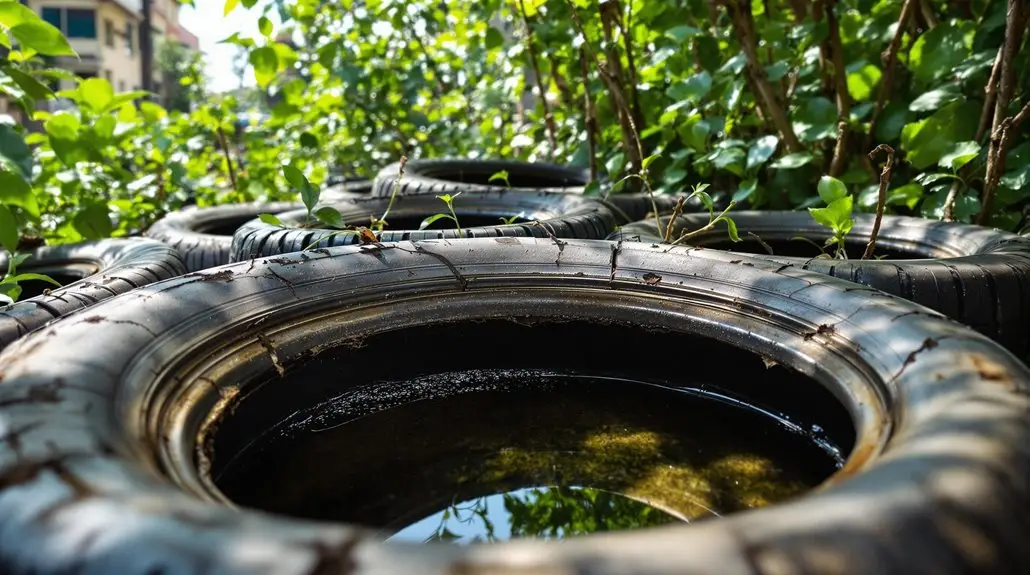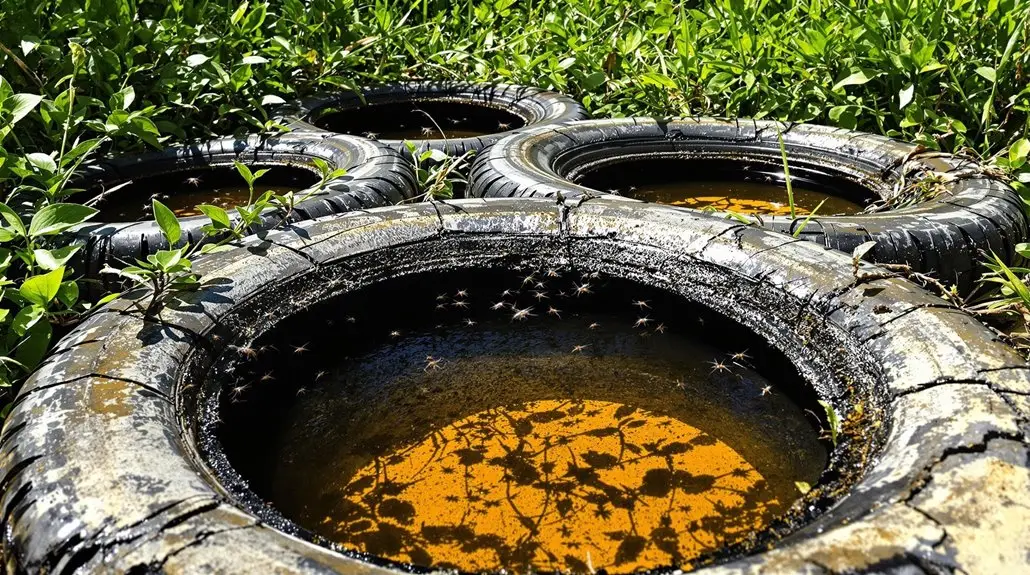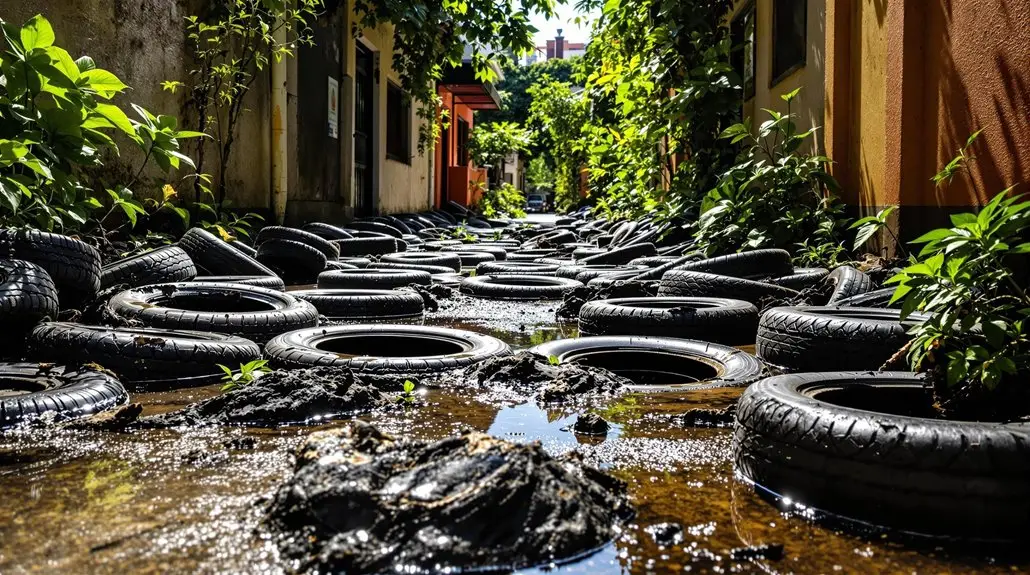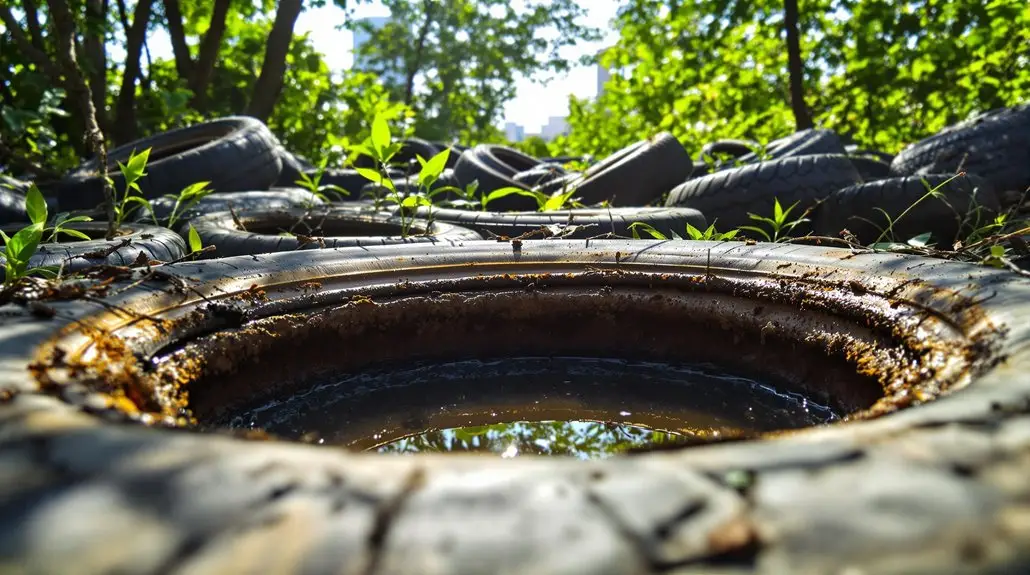Researchers investigated the connection between discarded vehicle tires and mosquito vector populations in New Orleans, focusing on various socioenvironmental factors. They found that low-income neighborhoods, which experience higher tire dumping rates, also face greater public health risks due to intensified mosquito breeding. Tires collect stagnant water, providing ideal habitats for species such as *Aedes aegypti* and *Aedes albopictus*, which are known to spread diseases like West Nile Virus and Zika. Socioeconomic disparities influence awareness and management of these risks, indicating a pressing need for community engagement and effective public health strategies to address tire waste and mosquito control. Further insights await your exploration.
Key Insights
- Discarded vehicle tires create ideal breeding habitats for mosquitoes, particularly *Aedes albopictus* and *Aedes aegypti*, enhancing vector abundance in New Orleans.
- Low-income neighborhoods, characterized by higher tire dumping, experience increased mosquito populations due to socioeconomic disparities and limited public awareness of health risks.
- Urban heat islands exacerbate mosquito proliferation in low-vegetation areas, linking environmental factors to increased vector abundance in disadvantaged communities.
- Effective management strategies, including community engagement and proper tire disposal, are crucial for controlling mosquito populations associated with discarded tires.
- Preventative measures, such as treating tires and reducing water retention, can significantly mitigate mosquito breeding opportunities related to discarded vehicles.
Socioeconomic Influences on Tire Abundance

Socioeconomic influences play an essential role in the abundance of discarded vehicle tires in various communities. Research indicates that median income levels are inversely related to tire dumping, meaning that low-income areas tend to have a higher prevalence of tire waste, while higher-income neighborhoods experience less of this issue. Residents in wealthier communities often exhibit greater public awareness regarding tire dumping, leading to increased reporting and fewer discarded tires in their environments.
Home vacancy, which frequently correlates with low income and blight in urban neighborhoods, also contributes to higher tire abundance. Vacant properties attract tire dumping, as they provide an unmonitored space for disposal, and this phenomenon is exacerbated in densely populated areas facing economic challenges. Furthermore, discarded vehicle tires serve as key habitats for mosquito vectors, particularly in low-income neighborhoods where awareness is low.
Curiously, population density inversely relates to tire abundance; sparsely populated regions frequently become hotspots for discarded tires, as fewer residents are present to report or address the issue actively.
Moreover, public awareness of the relationship between discarded tires and potential health hazards, such as mosquito breeding, is remarkably lower in low-income areas. This lack of awareness affects residents’ willingness to report tire dumping, which is typically higher in affluent communities.
Consequently, socioeconomic factors greatly influence the distribution of discarded vehicle tires, revealing disparities in awareness, reporting, and ultimately, the risk of associated health issues. Understanding these dynamics is vital for addressing the tire abundance problem and its implications for public health.
Mosquito Habitat and Species
A variety of habitats support mosquito populations, considerably influencing their abundance and distribution. Natural environments such as woodland pools, red maple swamps, and salt marshes provide essential breeding sites, as these wetland areas can retain water year-round or temporarily after rainfall or snowmelt.
Additionally, tree holes, rock pools, and beaver impoundments serve as natural breeding locations for various mosquito species. Man-made habitats also contribute greatly to mosquito populations; containers like discarded tires, empty jars, and pet dishes can hold water, creating ideal conditions for breeding. Remarkably, species such as *Aedes albopictus* and *Aedes aegypti* thrive in these artificial environments, particularly in stagnant water found in discarded tires. The presence of biological mosquito stations can help in managing these breeding sites effectively.
Different mosquito species exhibit specific habitat preferences, further shaping their populations. For instance, *Culex quinquefasciatus* typically inhabits permanent and polluted water bodies, while *Ae. albopictus* and *Ae. aegypti* prefer temporary water sources, including those found in discarded containers and flower pot saucers.
Other species, such as *Anopheles*, *Culiseta*, and *Coquillettidia*, flourish in diverse water types, including freshwater and brackish swamps. The conditions necessary for mosquito breeding include stagnant water for egg-laying, along with hot, humid environments that facilitate larval development. In addition, *mosquitoes play a role in ecosystems as pollinators and prey*, which highlights their ecological importance beyond vectoring diseases.
With eggs that can hatch within days in warm conditions or remain dormant for years, mosquitoes can quickly adapt and thrive in various ecological settings, underscoring the importance of understanding their habitats for effective management strategies.
Urban Heat Islands and Mosquitoes

Urban heat islands (UHIs) greatly influence mosquito populations, particularly in cities where concrete and asphalt amplify temperatures. Research indicates that the abundance of *Aedes aegypti*, a primary mosquito vector, is highly predictive in areas experiencing high heat levels. These mosquitoes thrive in UHI environments due to their tolerance for increased temperatures and ability to withstand egg desiccation.
Significantly, low-income neighborhoods, characterized by minimal vegetation and extensive urban infrastructure, exhibit elevated UHI effects, which further supports the proliferation of *Ae. aegypti*. In contrast, *Aedes albopictus*, another prevalent species, is commonly found in cooler areas, highlighting the important impact of temperature variation on species distribution. Furthermore, discarded tires serve as significant mosquito development sites, exacerbating the challenges faced by these communities. The presence of standing water in these tires creates ideal breeding conditions for mosquitoes.
The relationship between socioeconomic factors and UHI levels is essential; higher tire abundance correlates with lower median income and population density, suggesting that lower-income neighborhoods face greater challenges regarding mosquito habitats.
The lack of green spaces in these areas exacerbates UHI effects, as vegetation can mitigate heat through shading and evapotranspiration. Consequently, urban planning must prioritize the development of managed green spaces, particularly in disadvantaged communities, to reduce UHI impacts and, ultimately, mosquito abundance.
Public Health Risks
The threat posed by mosquito-borne diseases underscores the urgent need for effective public health measures. West Nile Virus (WNV) stands as the leading cause of mosquito-borne illnesses in the United States, presenting symptoms like fever, headache, and body aches. Although many infected individuals may remain asymptomatic, severe cases can lead to long-term neurological issues or even death. Additionally, current statistics in Massachusetts indicate an ongoing risk that necessitates increased awareness and preventive actions.
Eastern Equine Encephalitis (EEE), while rare, is another severe risk, with symptoms including seizures and behavioral changes, making it crucial to remain vigilant. Other diseases such as Zika virus, Chikungunya, and Dengue fever also pose significant public health concerns. Effective pest control is critical in minimizing breeding sites for mosquitoes, such as discarded tires.
Certain populations are more vulnerable to these diseases. Outdoor workers and travelers to outbreak areas often face higher risks, while individuals with underlying health conditions or weakened immune systems may experience more severe consequences.
Furthermore, low-income neighborhoods, particularly those with high mosquito abundance due to environmental factors like discarded tires, can see increased transmission rates.
Preventative measures are essential in mitigating these risks. Eliminating standing water and using insect repellents containing at least 30% DEET are fundamental strategies. Additionally, ensuring that windows and doors are screened, and closing them during peak mosquito activity can further protect against bites.
Public education campaigns conducted by local mosquito control boards serve to raise awareness, emphasizing the importance of recognizing symptoms and seeking timely medical attention. Addressing these public health risks requires concerted efforts from communities and health officials alike, fostering a more secure environment for all.
Strategies for Effective Intervention

Effective intervention strategies are fundamental for tackling the problem of discarded vehicle tires and the subsequent rise in mosquito abundance. One of the most effective approaches involves promoting proper tire disposal. You can encourage residents to utilize municipal services for tire collection, as data from 2010 to 2018 indicate a considerable increase in tire dumping.
Collaborating with local waste management can facilitate free or low-cost tire collection services, while educating the public on the importance of correctly disposing of tires will help reduce mosquito breeding sites. Implementing strict policies to penalize illegal tire dumping can further deter improper disposal.
In addition to proper disposal, modifying tire environments can considerably prevent mosquito breeding. Storing unused tires in enclosed areas and covering them during the breeding season minimizes water accumulation. It’s essential to guarantee that covers don’t create additional breeding sites by trapping water. Regular inspections will help identify any signs of water accumulation, as discarded tires are ideal breeding sites for female mosquitoes.
Using larvicides also plays an important role in controlling mosquito populations. You might consider treating tires with *Bacillus thuringiensis israelensis* (Bti) granules or briquettes, as well as exploring growth regulators, oils, or monomolecular films as alternative treatments.
Applying these treatments regularly during the mosquito breeding season and monitoring their effectiveness will enhance control efforts.
Finally, altering tire structure by cutting or shredding can reduce water retention. Cutting tires in half or chopping them into small pieces will prevent them from holding water, thereby decreasing mosquito breeding opportunities. Proper disposal of these cut materials is fundamental to avoid creating new breeding sites.
Frequently Asked Questions
How Can Individuals Report Tire Dumping in Their Neighborhoods?
To report tire dumping in your neighborhood, you can call Louisiana’s LDEQ hotline at (225) 219-3640 or file an online complaint at www.deq.louisiana.gov/page/file-a-complaint-report-an-incident.
Additionally, document the vehicle’s details, time, date, and specific location of the incident. Taking photos can also provide valuable evidence.
Engaging your community by forming a neighborhood watch or collaborating with neighbors can further enhance monitoring efforts and deter illegal dumping activities.
What Specific Diseases Are Spread by Mosquitoes in New Orleans?
In New Orleans, mosquitoes spread several diseases, including West Nile Virus (WNV), Saint Louis Encephalitis (SLE), Eastern Equine Encephalitis (EEE), and Zika Virus.
WNV is the most common, often affecting individuals over 50. SLE is also serious for those 60 and older.
EEE, while rare, can be deadly. Zika Virus poses risks, particularly for pregnant women, as it can lead to severe birth defects.
Awareness of these diseases is essential for public health.
Are There Any Community Programs Addressing Tire Dumping Issues?
Yes, several community programs tackle tire dumping issues effectively.
For instance, Alabama’s Scrap Tire Right of Way Program provides counties up to $150,000 to clean up discarded tires and encourages environmentally responsible disposal.
Similarly, North Central Texas has a Regional Tire Task Force that funds collection events, while Illinois EPA conducts forced removals when tire accumulations threaten public health.
Tennessee’s Waste Tire Program focuses on education and prevention, raising awareness about illegal dumping consequences.
How Do Discarded Tires Affect Local Wildlife Beyond Mosquitoes?
Discarded tires negatively impact local wildlife beyond mosquitoes by creating hazardous environments.
These tires can trap animals, like hermit crabs, leading to starvation and death, as they struggle to escape.
Additionally, leached toxins from tires contaminate soil and water, harming various species and disrupting ecosystems.
The accumulation of standing water in tires also attracts pests, further threatening local wildlife.
Addressing these issues is vital for maintaining ecological balance and protecting biodiversity.
What Role Do Local Governments Play in Tire Disposal Management?
Local governments play a monumental role in tire disposal management, ensuring that discarded tires don’t become breeding grounds for pests.
They’re responsible for establishing waste tire collection sites, enforcing regulations, and ensuring compliance among collectors and processors.
Additionally, they allocate funds generated from tire fees to support cleanup efforts and community education initiatives.
Final Thoughts
In examining the relationship between discarded vehicle tires and mosquito vector abundance, researchers reveal critical connections that underscore the significance of socioenvironmental factors. By understanding how socioeconomic influences, urban heat islands, and mosquito habitats interact, public health officials can formulate focused strategies for effective intervention. Addressing these challenges not only protects populations from public health risks but also fosters a healthier, happier environment, ultimately ensuring that communities can combat mosquito-borne diseases more effectively and efficiently.
The Path to a Healthier South Florida: A Call to Action
To truly make a difference in the fight against mosquito-borne diseases, it’s essential for residents and community leaders in South Florida to take proactive measures. Join forces with NaturePest Holistic Pest Control to tackle the challenges posed by discarded tires and their role in mosquito proliferation. Together, we can create a safer, pest-free environment for all. Let’s work hand in hand to protect our communities and promote public health!



